

Exploring our past to sort out myth from reality
Share this Page on
Facebook or Twitter

These are the voyages of the TimeShip Anachron.
Our Mission: To boldly explore the past, dispelling
mythinformation and mythconceptions
of American History along the way.
 Visit us on Facebook
Visit us on Facebook
Meet Mythamerica: SNAPSHOTS
The Birth of Labor Day:
Rooted in Pullman Hell
“We are born in a Pullman house, fed from the Pullman shops,
taught in the Pullman school, catechized in the Pullman Church,
and when we die we shall go to the Pullman Hell.”
(Pullman Company employee, c. 1894)
An odd…and obviously sarcastic…quote! Just who was “Pullman,” and what kind of Hell did he represent? And what does any of that have to do with the American celebration of Labor Day?
The answer takes us back to the Chicago Columbian Exposition/World’s Fair of 1893 with its “White City” centerpiece, built right on the shore of Lake Michigan near downtown Chicago. [You can read a brief overview of that amazing, stupendous World's Fair beginning with the Meet MythAmerica article titled "Thine Alabaster Cities."]
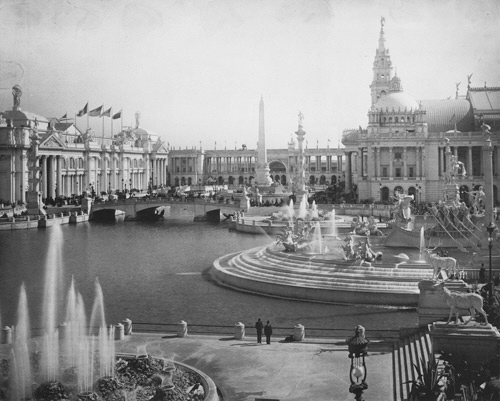
The Fair with its astounding monumental architecture lasted only six months, opening on May 1, 1893, and closing on October 31, 1893. By June 1894, the exhibits had all been removed from the buildings of the White City, and those grandiose buildings were sitting empty. They looked like they were made of marble and other permanent materials, but were actually made of wood and metal frame covered with an easily-
There were over 200 such buildings on the grounds. Eleven of them, referred to as the "Court of Honor" shown above, were gigantic classically-
But unlike the classical European buildings they were meant to imitate, they weren’t truly monumental —they were basically ephemeral fire traps. Which became obvious on the night of July 5. For by the next day, THIS is what the White City looked like.
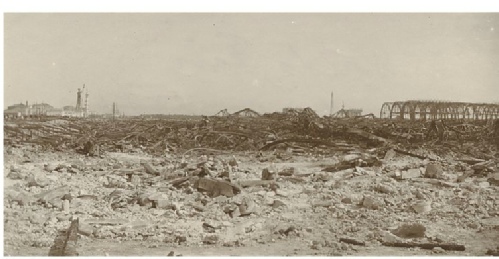
A small fire had started in one of the buildings around 7 PM. By the time the fire department had been called, and arrived on the scene, it had spread rapidly, gutted that building, and had leapt from roof to roof throughout the grounds, pushed on no doubt by the perpetual winds coming off the lake. One by one the burning roofs of the buildings came crashing down taking the whole structures with them. It took barely two hours for the whole beautiful "White City” shown in the earlier photo to be reduced to the rubble you see above!
Some historians have concluded the likely cause of the fire was the presence in the buildings of “squatters,” homeless refugees from the desperate financial "Panic of 1893" that occurred in the country during the period of the Fair and continued to spread its misery on into 1894. The winter of 1894 was one of the coldest, snowiest winters on record in Chicago—which is a frozen city every winter at best. And with the end of the Fair, thousands of men who had been employed in temporary jobs building and maintaining and dismantling the Fair were suddenly “cast off” like an old shoe, into the huge ranks of the already-
With conditions in the economy not improving as 1894 drug on, there were no doubt still plenty of squatters in the buildings by June. They would still have been using makeshift fires for heating and cooking, and one of those fires could easily have spread.
But particularly at the time, there was a different speculation on the cause of the fire that destroyed the White City…arson. And not just an isolated case of arson. For there were major incidents of arson throughout the Chicago area in the same time period…such as this one the very next day, on July 6, in which 700 railroad cars were destroyed by arsonists in the South Chicago Pandhandle rail yards.
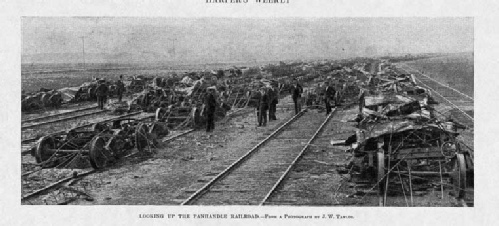
And that brings us to Mr. Pullman and his Hell.
Back to the Beginning
In 2016, when there are barely any “passenger trains” left in the United States, the name Pullman isn’t familiar to most people. But in my youth back in the 1950s, it was a name that almost everyone knew. Actually, I never took a long-
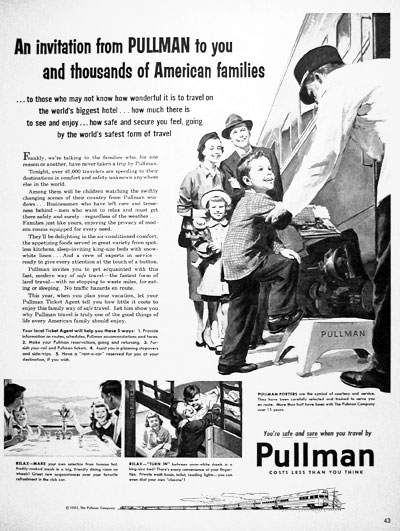
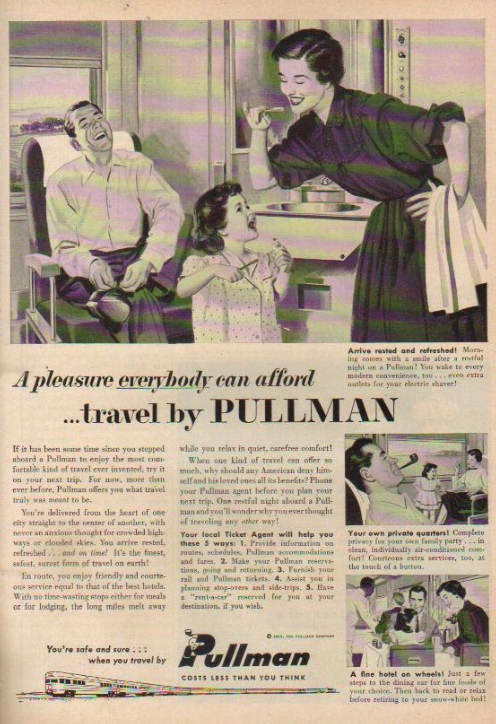
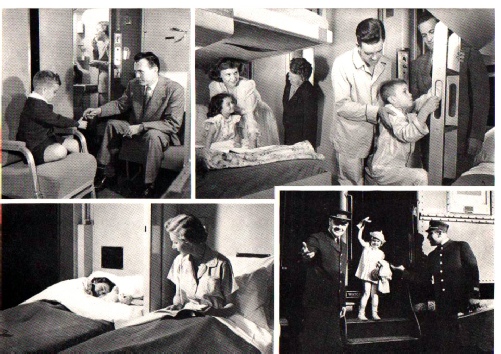
In spite of the insistence of the ad above that this was a pleasure "everyone" could afford, that pretty much meant "everyone in the middle and upper classes." You paid a premium above the cost of your railroad ticket in order to enjoy this convenience. I'm sure that in the earlier days of Pullman cars, they were even less likely to contain "everyone" who was traveling by rail. There was a definite emphasis in Pullman cars in the heyday of railroading in the Victorian era and the early 20th century on the kind of luxurious surroundings that wealthy people were accustomed to.
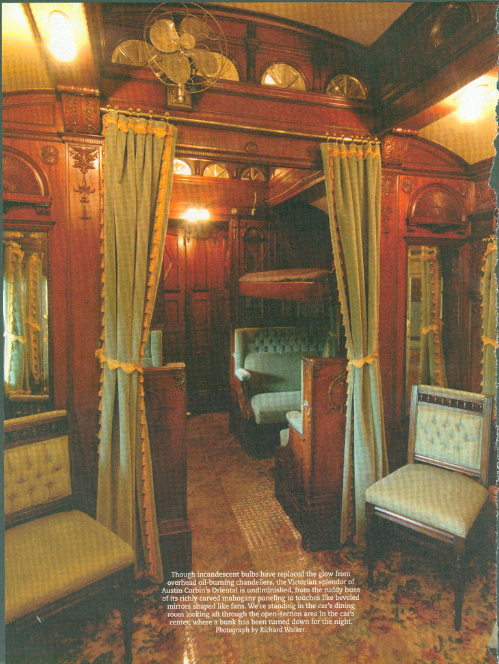
And why “Pullman” car?

Because Mr. George Pullman, who built some of the earliest such cars clear back in the 1860s, cornered the market on “sleeping cars” very early. Eventually almost all such cars used on railways in the US were Pullman models. The company started by him continued manufacturing them right up to 1980. (The company also produced railroad cars with dining facilities, lounges, individual private "hotel-
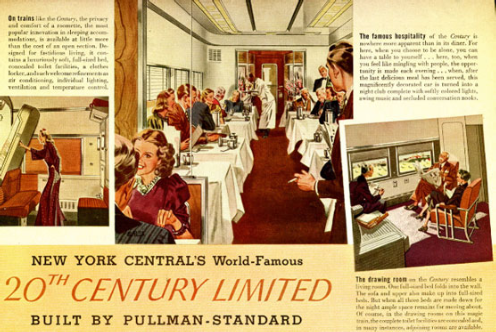
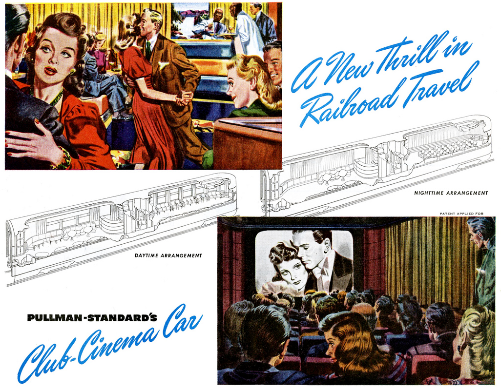
Industrialist George Pullman was born on [March 3] 1831 in Brocton, New York.
When Pullman, a school dropout, arrived in Chicago at the age of 14, he had an idea for solving the problem of knee-
And as the years went by Pullman made many improvements in his “Pullman cars,” making them more and more luxurious and appealing to the upper classes. The orders kept rolling in and the business kept growing.
All this was going on at the same time that Robber Barons such as John D Rockefeller and Andrew Carnegie were beginning their meteoric careers as Corporate Capitalists. Pullman watched as many corporations began to have problems with worker unrest and strikes over pathetic wages and miserable working conditions, and decided to institute a system that he expected would minimize such problems for his own business.
Styling himself as a “welfare capitalist,” Pullman wanted to inspire contented laborers without paying high wages, and in the service of this goal he designed (with architect Solomon Beman) and built the town of Pullman (now in Chicago’s South Side) -
At first glance, this lament from the employee seems almost crazy. Have a look at the town as it was in the early 1890s. Here's one of the main streets, with houses for Pullman factory management.
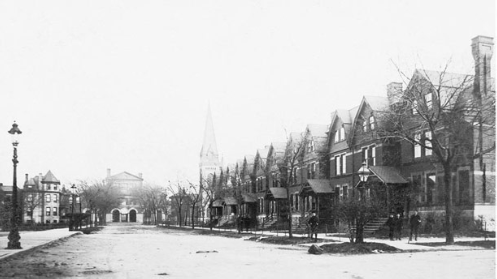
Here are blocks of apartment housing for the "average" worker.
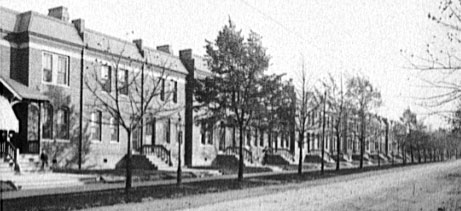
Here is the central "Arcade," which housed the library, theater, bank, and more.
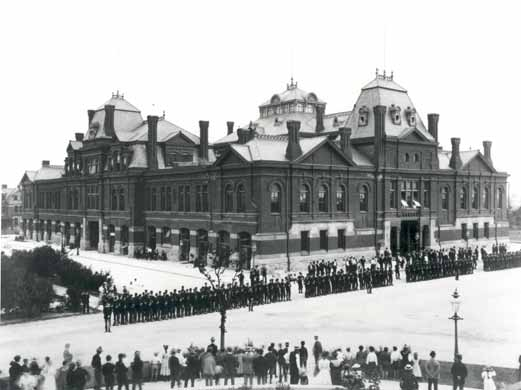
Here's the Hotel Florence (in its restored condition in modern times) where important corporate guests were entertained by George and the factory management. It was also the only place in town to get an alcoholic beverage. Pullman was, by design, a dry town, and since the average workman couldn't afford to hang out at the Florence, he had to go elsewhere if he wanted a brewski.

And here is "THE" Church.
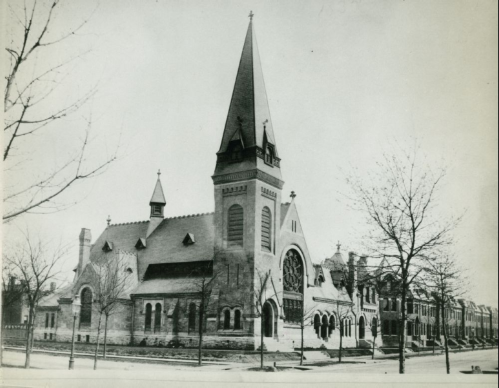
The public buildings planned by Pullman contributed to his model community and included a school offering free education through eighth grade, a livery stable, a market that sold meat and vegetables, the Casino, the Hotel Florence, and the two-
Pullman built one church, the Green Stone Church, and a parsonage and established a lumber yard, ice houses, and a dairy farm with one hundred cows to provide the residents with milk, cream, and butter. Gas lights illuminated the macadamized streets and plank sidewalks, and two parks, Lake Vista and Arcade Park, beautified the town. The parks featured winding roadways for Sunday drives, a lagoon with a waterfall, a bandstand, numerous flowerbeds, and a Playground and Athletic Island for sports.
About 12,000 people lived in the town of Pullman, and during the Chicago World’s Fair of 1893, more than 10,000 visitors toured this workers’ utopia. [Source]
Why, you'd almost think it was an early incarnation of Walt Disney's later idea for an "Experimental Prototype Community of Tomorrow"! Indeed, a virtual carefully planned little Utopia! But it had a darker side.
George Pullman believed that he had satisfied every desire of his workers in his model city. A calculating capitalist, however, he had entered the venture expecting to gain a six percent dividend on his investment as well as preserve a stable labor force. To him, workers were simply a commodity to be controlled, and his rule over the town and his laborers was rigidly paternalistic. As a result, the realities of life in Pullman were far from ideal. Theoretically, workers could live anywhere, but in actuality, they would not keep their jobs if they did not live in Pullman.
Since he owned the entire town, his domination reached from the maintenance of all utilities to the election, through threats and intimidation, of all town officials, including the school board. When signing the leases to their homes, workers had to agree to rules covering everything from the care of their lamps and stoves to curfews, dress codes, and individual cleanliness and conduct, especially drunkenness. This paternalistic authority gave them little freedom. [ibid.]
In other words, Pullman didn’t really consider his community as a “blessing to the employees.” He considered it a money-
He built that community library—but only employees able to pay a three dollar fee had access. He seemed to honestly believe that all “religions” were the same, and that thus they ought to just merge…so he built only one church for the whole community. When the local people didn’t buy into his “one world religion” idea, he offered to rent the church building out to approved groups…”He wasn’t a man to let you pray for free,” as one newspaper put it. But the rent was so high no groups could afford it, so it mostly sat empty.
The streets of Pullman were kept clean and the rental units kept repaired…but fees for these things were all deducted from workers’ salaries.
When the government outlawed this, they simply gave them two checks, one which covered their expenses, which they had to sign over to the Pullman bank, and the other, if any was left, they could keep for themselves. [ibid]
The deductions typically left workers with no more than $3 a week to live on [making that $3 library fee pretty unattainable for most—if they wanted to put food on the table and clothes on their children], some even less, since they made only 4 to 16 cents an hour [for a twelve hour day]. The pastor of the Pullman parish church told of a man who “has a paycheck in his possession of two cents after paying rent ....He had it framed.” [Source]
Regarding the reality of community life in Pullman:
By 1892 the community, profitable in its own right, was valued at over $5 Million. Pullman ruled the town like a feudal baron. He prohibited independent newspapers, public speeches, town meetings or open discussion. [Source]
In 1885 the illustrious Prof. Richard Ely wrote in Harper’s Weekly that the power exercised by Bismarck (the unifier of Germany), was “utterly insignificant when compared with the ruling authority of the Pullman Palace Car Company in Pullman.” The Rev. William H. Carwardine, the Methodist minister in Pullman, characterized the town as a “civilized relic of European serfdom.” [Source]
All of this was basically tolerated by workers who had little choice, and who probably counted their blessings that at least they weren’t living in a slum tenement in a crumbling area of Chicago. Besides, when you are a semi-
But then came the Panic of 1893, which began during the run of the Columbian Exposition.
A “recession,” as we would call it now, gripped the nation’s economy beginning in 1893. Orders for Pullman cars fell off and management began a program of lay-
And thus the Pullman workers staged a walkout.
In 1894 the model town of Pullman became the storm center for one of the classic labor struggles in American social history. What began as a revolt of the Pullman Shops employees against wage cuts and oppressive company practices, escalated into a national railway workers’ boycott directed against the handling of trains carrying Pullman cars. [ibid.]
Many of the Pullman factory workers joined the American Railway Union (ARU), led by Eugene V. Debs, which supported their strike by launching a boycott in which ARU members refused to run trains containing Pullman cars. The plan was to force the railroads to bring Pullman to compromise. Debs began the boycott on June 26, 1894. Within four days, 125,000 workers on twenty-
The Mayor of Chicago and the Governor of Illinois wanted to handle the situation with possible arbitration and with their own law enforcement agencies, believing that they might eventually be able to bring the situation to a peaceful solution. They were furious when President Cleveland overruled them and sent in US troops…allegedly to “keep the peace.” Instead that action so infuriated the workers—because it was obvious the government was “taking sides” with the employers—that it escalated the violence. Union mass meetings in response erupted in violence in several instances, including the one mentioned above where 700 freight cars were torched in a Chicago rail yard.
[The boycott and strike] was followed by federal intervention with almost half the U.S. Army at the service of the employers. [12,000 troops... the US army after the Civil War and Reconstruction was over was kept quite small.]
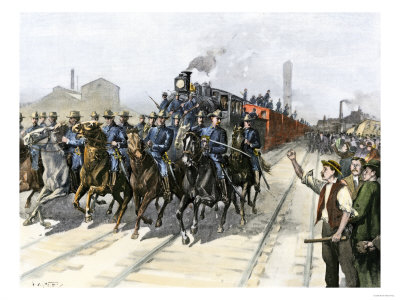
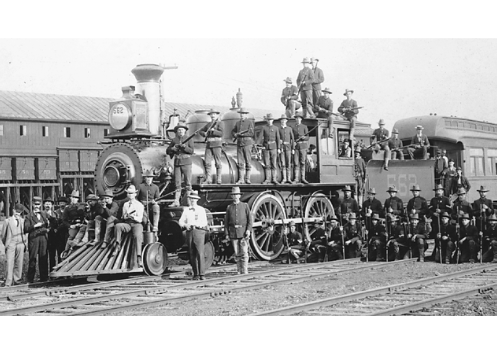
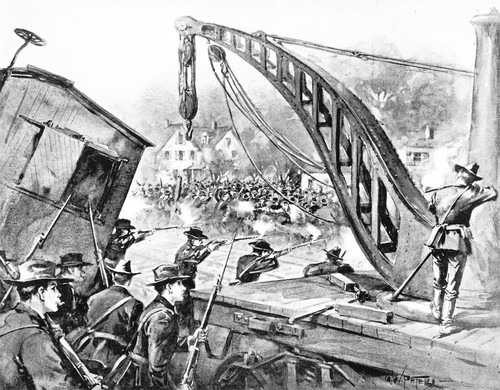
The use of army troops brought about a bitter dispute pitting the Governor of Illinois and the Mayor of Chicago against President Grover Cleveland, who had ordered the troops sent in. And that led to the eventual defeat of Cleveland in his bid for renomination by the Democratic Party two years later.
In the process of this epic tragedy, people were killed [according to some reports, 30 workers were killed and 57 wounded during the strike], the American Railway Union was destroyed, the Pullman workers were forced back to work on the company’s terms, and George Pullman became a reviled caricature of the hard-
Given the dire circumstances of the workers before the strike, being forced to go back to work on the same terms…starvation wages for working twelve hours a day…is helpful evidence in establishing a point I have often made in blog entries-
There was a tiny bit of justice that came out of the situation:
…In the months after the strike, a federal commission was convened to investigate its causes. The commission censured Pullman for charging excessive rent, for attempting to saddle his employees with all his company’s depression losses, and for denying the workers any protection or voice. [It even declared the Pullman company town to be “un-
In 1898, as the result of a lawsuit filed in the wake of the investigation, the Illinois Supreme Court ordered the Pullman Palace Car Company to sell its non-
And then there was this…
…Pullman died of a heart attack on October 19, 1897 at the age of 66. Funeral services were held privately at his mansion on Prairie Avenue in the afternoon. The funeral cortege arrived at Graceland Cemetery where elaborate preparations had made. A pit the size of an average room had been dug on the family plot, its base and walls of reinforced concrete 18 inches thick. Into this the lead-
The pit was filled with concrete on top of which a series of steel rails were laid at right angles to each other and bolted together. These rails were embedded in another layer of concrete. It took two days to complete, then sod was put down.
These precautions were taken to prevent any desecration of the body — an unfortunate price Pullman paid for his victory in the Pullman strike.
Ambrose Bierce [famous journalist and satirist of the time] said, “It is clear the family in their bereavement was making sure the sonofab*tch wasn’t going to get up and come back” [Source]
I’m guessing that most of his former employees assumed George Pullman had gone to …Pullman Hell.
Yes, indeed, even for the great Mr. Pullman, the 90s weren’t so Gay after all.
And that brings us to Labor Day:
Six days after the strike ended in 1894, in an obvious attempt to "pacify" organized labor throughout the land after such an ignominious defeat for their group cause, legislation was hurried through Congress and signed by President Cleveland to finally establish Labor Day as an annual federal holiday.
Prompted by labor unions, some individual states had been holding celebrations in honor of "the working man (and woman)" at various times of the year since 1887. But the US congress had been dragging its feet up to this point about declaration of a national federal holiday. There had been proposals to establish such a celebration to coincide with the May Day (May 1) International Workers' Day observed in many countries. But President Grover Cleveland wanted to avoid any connection of the US federal holiday with THAT celebration, as it was a favorite of socialist and anarchist movements. So the "first Monday in September" date was chosen instead.
Unfortunately, over a century later, with a steep decline in the influence of the labor union movement in America, Labor Day is mostly recognized as a convenient excuse for a three day weekend just before school starts in the fall, and for back to school "Labor Day sales." But earlier in the 20th century, it rivaled the Fourth of July for enthusiastic, emotion-
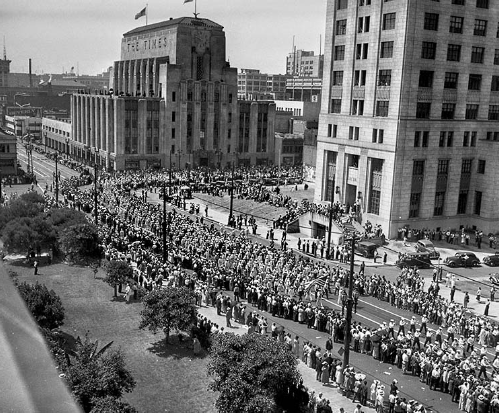
Similar festivities were common in small towns and big cities all over the country. Here are a few samples. (If you would like to see the photos below magnified so you can see some of the fascinating details, do this: Press down on the CTRL key on your keyboard, hold it down, and press the Plus key + one or more times, still holding down the CTRL key. Each time you press the Plus, the content on your screen will get bigger and bigger. To go back to regular size to finish reading this entry, press down on the CTRL key again, hold it, and press the Minus key -
Gladstone, Michigan 1911
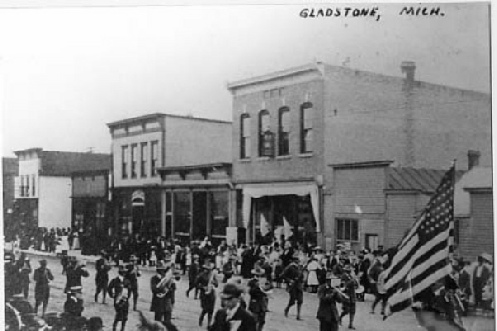
San Francisco 1939
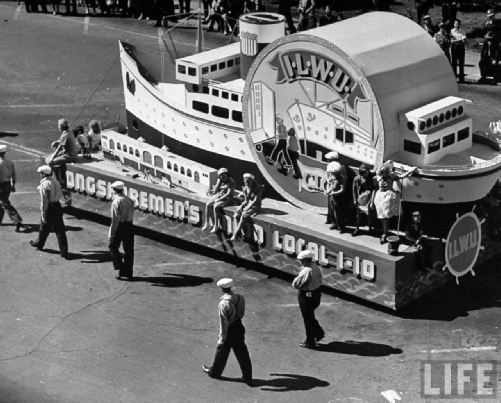
New York, circa 1900
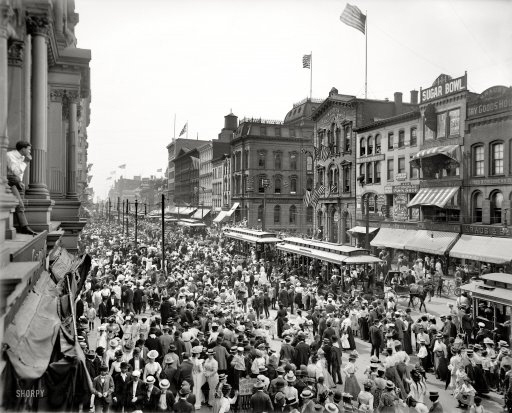
San Francisco 1910
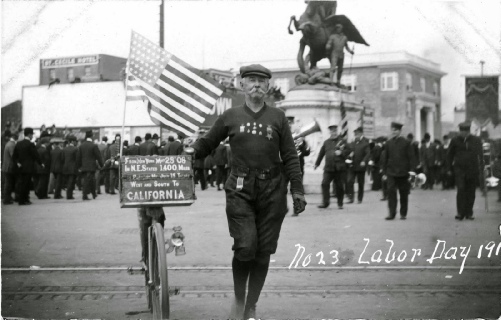
10,000 Amalgamated Clothing Workers (no doubt mostly women), Chicago 1915
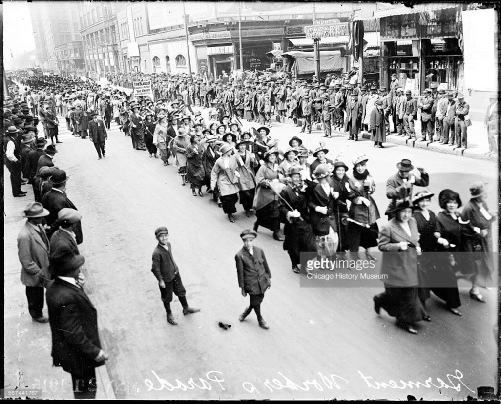
New York circa 1900

Quaker City Drum and Bugle Corps, Color Guard, Philadelphia 1941
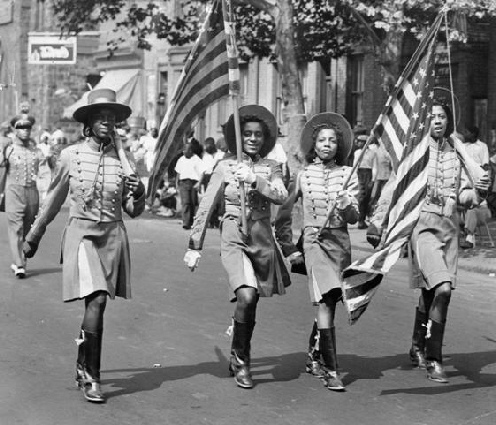
And finally…Buffalo, NY 1900 (The men in white were likely with the Union of Painters, Decorators, and Paperhangers.)
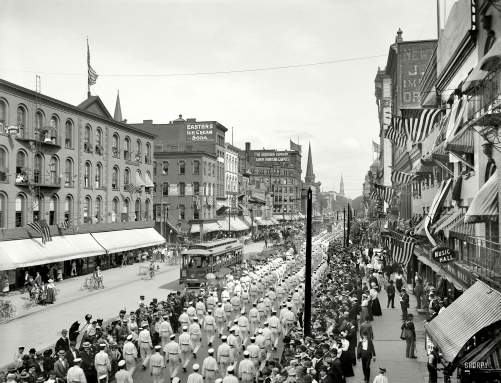
And you can even see a brief “live” video on Youtube of a Labor Day parade in Leominister, Massachusetts, from around the turn of the last century, at the link below.